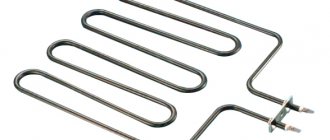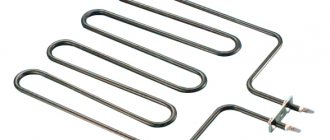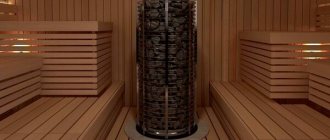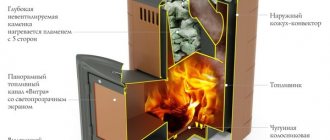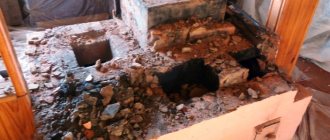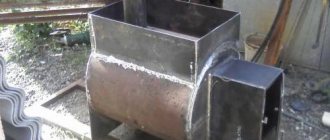Electric heater in the sauna
If there is a source of electricity nearby, it is better to use it and install an electric heater.
For good heating, a nominal voltage of 380 W is sufficient. The design is convenient, since you do not have to waste time and effort on preparing firewood, periodically cleaning the chimney of soot and performing other procedures. An electric stove is suitable for a sauna for several reasons. Modern versions are equipped with a timer and remote control, which ensures comfortable operation. Heating elements are used to heat stones. At the same time, heating elements have several significant disadvantages. First of all, this is a limited resource, which varies from 2 to 5 thousand hours. It is easy to replace a worn or burnt part and install a similar one yourself.
You can also use a tape-plate as a heating element, which has a reduced temperature. The indicators in this case vary from 200 to 400°C, while the heating of the heating elements is much stronger and reaches 800°C. The working life of tape-plates is many times higher; they also create gentle indoor conditions and do not overheat the air. As a result, a comfortable stay in the sauna is created and energy consumption is reduced.
Safety precautions
During the installation of an electric heater, it is necessary to pay attention to safety precautions. First of all, it is necessary to arrange individual grounding. A simple neutral wire from a substation is not enough
If it is impossible to install your own grounding, the problem is solved by grounding. To do this, the zero terminal, which extends from the distribution board, is combined with a wire that is the grounding of the electric furnace
A simple neutral wire from the substation is not enough. If it is impossible to install your own grounding, the problem is solved by grounding. To do this, the zero terminal, which extends from the distribution board, is combined with a wire that is the grounding of the electric furnace.
Another important point is the emergency shutdown. A similar measure is necessary for every electric furnace, regardless of the type of structure. Emergency shutdown operates automatically and de-energizes the oven if a short circuit or any other problem occurs. Typically, cables that are resistant to moisture and temperature changes are used for structures. The dimensions of the stove are calculated in accordance with the area of the heated room. For example, for a sauna with a size of 1 m2 you will need an electric furnace, the power of which varies from 1.4 to 1.8 kW.
Operating rules
A do-it-yourself electric oven must be operated in a room with a reliable ventilation system. The electrical wiring must be in good working order, its energy capabilities allow it to withstand the load from this electrical appliance, eliminating the risk of a short circuit.
In addition, there are a number of rules that must be followed:
- Do not connect the device to the power supply system without sufficient water in the device.
- Before the first fire and periodically during operation, measure the resistance from the network, which should not exceed 3 - 5 ohms.
- To prevent damage to the heating elements due to scale, you need to fill the device with water softened with vinegar or citric acid.
- Once every six months, the stones are moved into the electric furnace and cleaned of dust and cracked elements.
- If in winter the bathhouse is not heated regularly, then after each visit to the bathhouse the water from the stove must be drained, since it can expand when freezing and break the connecting seams of the body.
Tools
The tool kit should consist of:
- tape measure and square;
- Bulgarians;
- welding machine with a set of electrodes with a diameter of 3 mm;
- cutting wheels for metal;
- file;
- hammer, pliers.
You also need to take care in advance about personal protective equipment during welding work:
- protective mask;
- workwear made of dense material;
- closed shoes;
- rubber (dielectric) gloves.
How the electric heater "Harvia" works
The design of any stove determines its capabilities. Let’s briefly look at the design of the Harvia electric sauna stove, taking into account that many electric heaters are designed in a similar way. So, an electric stove is a hollow body with heating elements installed inside
So, an electric stove is a hollow body with heating elements installed inside.
Ten
In turn, a heating element is a hollow tube with a spiral inside. Under the influence of current, the spiral heats up, the tube serves to protect it. (Tubular electric heaters are the most common.)
This is what the heating element for the Harvia electric heater looks like
Heating elements are very fragile and do not withstand pressure, bending and contact with water. Therefore they often fail.
Carefully! The manufacturer does not consider cases where this occurs as a violation of operating rules to be a reason for warranty repair. For example, you accidentally tilted one of the elements and it broke
If one of your heating elements has burned out, you can replace it yourself or with the help of a specialist. The main thing is to write off the markings, including the code and power, so that the store can select the right replacement model for you. Or you can take the burnt-out heating element with you.
Stones
The Harvia electric heater does not work without stones. More precisely, it doesn’t work for long. Heating elements must transfer heat to stones, which have a high heat capacity and prevent the heating elements themselves from overheating.
Stones for the Harvia electric heater on the manufacturer’s website
According to the manufacturer’s own experts, only crushed stones with an uneven surface are suitable for use in heaters. They do not recommend using bunded ones, as they have less surface area.
In addition, it is important to follow the rule of free laying, with gaps between the stones; this is only possible if there is uneven chipping
Attention! The manufacturer claims that there is no place for ceramic, talc and smooth stones in its heaters. For his part, he offers crushed stone measuring 5-10 cm, which is suitable for small and medium-sized heaters
Stones from 10 to 15 cm are suitable for either wood-burning or high-power electric heaters (for example, Symphony (not produced) and Forte: AFB4, AFB6 and AFB9)
For his part, he offers crushed stone measuring 5-10 cm, which is suitable for small and medium-sized heaters. Stones from 10 to 15 cm are suitable for either wood-burning or high-power electric heaters (for example, Symphony (not produced) and Forte: AFB4, AFB6 and AFB9).
IMPORTANT! Turning on the Harvia electric sauna stove without stones between the heating elements is strictly prohibited. As for breeds suitable for an electric stove, then anything that is generally suitable for a bath will do.
We have written a lot about bath stones, take an interest. But Finns usually sell branded soapstone for their stoves. Here it’s up to you to decide whether to take it or another stone. The main thing is to take a smaller fraction than for a regular wood-burning heater.
As for breeds suitable for an electric stove, then anything that is generally suitable for a bath will do. We have written a lot about bath stones, take an interest. But Finns usually sell branded soapstone for their stoves. Here it’s up to you to decide whether to take it or another stone. The main thing is to take a smaller fraction than for a regular wood-burning heater.
Useful video
Watch a Finnish video about how to place stones correctly (if you need more details, we have a whole article about laying stones in electric heaters):
Popular manufacturers of electric heaters
An important aspect that you need to pay attention to when choosing an electric sauna stove is the manufacturer. Preference in this regard is traditionally given to Finnish companies that have long proven themselves in this niche
The first step is to look at the following brands of stoves:
- Harvia. This company is a leader in the production of bath equipment. Among Harvia products there are a variety of designs for home and public saunas - electric stoves, bath heating elements and other devices (for more details: “Which Harvia sauna stoves are most convenient to use”). Electric heaters from this company are convenient, compact and have an original design, for which consumers appreciate them.
- Tylo. A well-known Finnish company striving to implement innovative developments. A distinctive feature of Tylo devices is the flexibility of settings, which allows you to easily switch from wet to dry steam and vice versa due to a unique approach to drying the air in the steam room.
- Tulikivi. The products of this company are designed primarily for supporters of environmentally friendly bath equipment. The design of Tulikivi devices includes various natural materials - from granite to natural ceramics. The result is environmentally friendly and beautiful stoves - to be convinced of this, just look at any photos of electric stoves.
We suggest you read: How to insulate the ceiling in a bathhouse with your own hands
Choosing an electric fireplace (220 or 380 Volts)
The most important parameter when choosing an electric heater is the type of heating element. The heater can be a heating element, a tape heater (low-temperature tape-plate) or a combined heater. The tape and combined types have great advantages, because heating elements are considered a more vulnerable and fragile element. It should be noted that the power of the electric furnace is selected in accordance with the volume of the room to be heated. The voltage required from the network, 220 or 380 Volts, will depend on the amount of power.
An electric fireplace can be used with stones that must be laid out without contact, next to the heating elements, have low thermal conductivity, the ability to withstand temperature changes, not collapse, and also have no odor. For example, you can use rocks such as gabbro-diabase, soapstone chloride, basalt and other options as bath stones. Choosing the design of an electric fireplace is quite simple: from simple models in a metal casing of all shapes and sizes to expensive mesh options, where exposed stones become the main decoration. There are also models with stone trim in the form of plates along all walls, which significantly increase the heat transfer of the equipment.
Electricity costs when using a heater
The main disadvantage of an electric furnace is its significant energy consumption, which entails an increase in monthly electricity costs.
The standard scheme for using a heater is as follows: carrying out procedures 2-3 times a week for 2 hours. If a heater with a power of up to 18 kW is installed in a private bathhouse, then 36 kW of energy per day must be allocated for bathing procedures, from 72 to 108 kW per week, from 288 to 432 kW per month.
This applies to large buildings; if the steam room is of modest size, located in a country house or in a city apartment, then it is enough to use a device with a power of up to 6 kW.
In this case, the calculations will be more modest: the procedures will require 12 kW per day, from 24 to 36 kW per week, from 96 to 144 kW per month.
To this item you can add electricity costs for connecting additional household appliances and devices. The amount received is the cost of maintaining a private steam room, which must be paid monthly.
The principle of an electric sauna
It is important for a novice master to understand the parameters in which an electric sauna differs from a classic or infrared installation. A sauna of this model is equipped as follows:
- The room, as in most cases, is lined with wood slats.
- An electric oven is installed in the center (most often, but there may be other options).
- The oven may have different structural options, but the principle of its operation is the same for all models. A 220-volt electric sauna heater is standard.
- The furnace heats the stones located behind the protective limiter.
- The heated stones heat the air in a sealed room.
The location of the stove in the center is most optimal, as it allows warm currents to spread evenly throughout the room.
Materials
To make an electric sauna stove with your own hands, you will need to purchase the following materials:
- several electric heating elements (3-4 pcs.);
- stainless steel sheets with a thickness of at least 3 mm;
- fittings with a diameter of 6 - 10 mm;
- power cable;
- rheostat that regulates power;
- temperature sensor;
- asbestos cement slab;
- a can of heat-resistant paint;
- backfill made of stone.
How to choose a good stove?
In addition to standard recommendations for power (1 cubic meter of steam room requires 1 kW of performance), it is necessary to take into account the heat storage capacity of the device - the higher it is, the less kilowatt is needed. The capacity of the stone is also important - it is directly proportional to the saturation of the air with steam.
Models with a multilayer metal body require a smaller safe distance to prevent fire, which means that the freed up space can be used for other needs. The most practical are angular variations - there will also be fewer indents here.
Closed or open heater - this is where user preferences come into play; the first solution is distinguished by expediency, safety, aesthetics, and compactness.
The built-in steam generator will never be able to imitate a Turkish hammam, but it is enough to increase the humidity to a comfortable level. If you plan to use a broom, it is better to choose a stove that can definitely be watered.
Built-in microclimate regulators are very inaccurate, since they reflect the state of the environment under the casing, and not in the room. Often a sensor triggers, automatically turning off the stove to avoid overheating. If there is a remote electronic control panel, you can also use an emergency shutdown, only in this case the sensors will be more accurate, since they are installed separately.
When choosing between flat strip and tubular electric heaters, you need to take into account that the latter are more compact and safe, and operate correctly.
Features of Christina stoves
Christina stoves are economical and efficient in operation, creating a pleasant microclimate in the sauna room. The models in the line are safe and can be used unattended because the timer turns them off automatically at the set time. The heater creates powerful convection currents, quickly warming up the steam room. The furnace material is stainless steel. The gentle heat provided by the Christina stove will provide an optimal atmosphere in family and commercial saunas.
Any water is suitable for this line, including without special preparation. You can add herbs, flavors, essential oils to the filling container - you will get an aromatherapy session. The buyer has a choice of digital and analog control panels. All models are comfortable to use, and the presence of a steam generator in them allows you to create steam of the required parameters.
Choosing an electric heater for a bath
When choosing an electric sauna heater, such important technical parameters as air heating temperature, humidity level, functionality and safety are taken into account.
Other important characteristics include:
- volume of the steam room;
- control system;
- heater type;
- appearance;
- certificates of quality and compliance.
Steam room volume
The power of the heating device is determined taking into account the volume of the room using the formula: per 1 cubic meter. m – 1 kW of electricity.
Control elements
The electric heater for saunas and baths has an effective control system, where the remote control allows you to select the optimal temperature mode for heating the air, as well as the duration of operation of the heaters.
Heating elements
Electric sauna heaters are equipped with tape, heating elements and combined heating elements. TEN (pipe) heaters provide heating temperatures of up to 850 degrees, but are prone to breakdowns.
Tape elements are economical and safe to use, and promote rapid heating of the air.
Combined heaters combine tubular and tape devices and are reliable, practical and safe.
Advantages of electric ovens Polytech and Christina
has been producing electric convectors, stoves and control panels for them since 1990. Its products are certified, have the necessary patents, are safe and reliable. Electric stoves for saunas and baths have an attractive price, are reliable in operation, and in terms of technical parameters are superior to a number of domestic and imported installations. The Atelier Saun store offers you original Polytech stoves with inertia-free tape and flat electric heaters of our own production - economical and not burning oxygen.
Conventional designs are unlikely to become obsolete (this is an all-time classic), but they present many problems in use. If you like everything to be clean, quick and hassle-free, choose electric heaters - prefabricated welded structures installed in steam rooms to heat rooms. Warm air is supplied to them through stones or using a fan. Electric ovens are:
• creating a comfortable microclimate in the steam room; • safety; • ease of operation; • affordable cost; • durability.
If we talk specifically about Polytech products, they are extremely economical - on average, one tenth of the electricity consumed is saved, and this is a lot. A device using inertia-free heaters operates several times longer than a conventional one, which means you won’t have to buy a new unit ahead of time. The designs on sale are divided into floor- and wall-mounted, they look attractive, and are equipped with a timer, an emergency shutdown function, and a temperature regulator.
Device and types
The electric furnace has a simple design consisting of a metal body, electric heaters and thermal insulation. The solid body is most often made of stainless steel. Inside it, a grate is installed on top of the electric heaters, which is completely filled with stones. The size and weight of these stones largely determines the rate of heating of the bath or sauna: the larger and heavier they are, the faster the room will warm up.
By design, furnaces can be open or closed. The devices of the first type are in greatest demand, as they not only warm up the bathhouse or sauna well, but also create good moist steam. For the body of such a furnace, nichrome wire is used, fixed in a ceramic heating base. Closed-type devices consist of a heat shield, heaters and a conductive element.
In addition to division by design, furnaces are divided by type of heater. They can be equipped with a tubular heating element or a strip heating element. The heating element is most often used, since its cost is lower than that of the second type of heater. Stones are placed on top of the tubular elements so that the room quickly heats up to the desired temperature.
The tape heating element is a metal strip. Compared to heating elements, it consumes less electricity and has a larger heat exchange area. But stoves equipped with this heater are more expensive.
There are models that have stone cladding. Such stoves protect against excess thermal radiation and make the heat and atmosphere in the bathhouse or sauna softer.
Pros and cons of ovens
Electric ovens have a number of advantages. They are much smaller in size than brick structures, and also warm up a bathhouse or sauna faster. An electric stove does not require solid or liquid fuel, which means you don’t have to waste time buying it, storing it and throwing it into the firebox, or organizing a storage space. It can be controlled remotely using a remote control.
Positive qualities of electric ovens:
- Heats up the room quickly;
- Retain heat in a bathhouse or sauna for a long time;
- They have compact dimensions (low-power models have dimensions of 50x50x50 cm);
- Quick and easy installation;
- There is no need to install a chimney to remove carbon monoxide;
- Easy maintenance and operation;
- They do not emit carbon monoxide.
All control of the device comes down to setting the required heating temperature on the controller. To protect against accidental overheating, a fuse is built into the oven. A large number of models of different sizes, designs and power allow you to choose a device to suit any room and needs. Also, due to the fact that solid fuel, such as firewood, is not used, there is no ash or dust, which greatly simplifies the process of cleaning a bathhouse or sauna.
Since the device automatically controls the temperature, this helps to significantly save electricity costs. When the set temperature is reached, the oven switches to economy mode. If the temperature reaches the lower mark, then it starts working at full capacity again.
About the future design
Construction of a homemade electric stove for a sauna
The simplest model of an electric stove consists of a box-shaped body, inside of which there is a tank with a door on the neck for adding water and several heating elements welded together. Stones are laid on top and between them. When heated, the stones release thermal energy into the steam room, raising the temperature in it to the optimal level.
For metal structural elements, stainless steel is used, which does not corrode in water, does not burn out under high temperatures and does not emit harmful substances.
If possible, the device is controlled by an electronic remote control, which should be located outside the steam room. It is connected to the furnace heating unit with an electric cable.
The heating system is activated by turning on the timer. The maximum permissible heating level for heating elements is 650ºС. If the temperature drops to 600ºC, the sensor is triggered and the “Heating” light comes on. The stones are heated when the timer is in standby mode.
As soon as the top layer of stones heats up to 550ºC, the timer is triggered and the light turns on in the “Ready” position.
Stones can also be placed on top of the body above the heating elements on a metal grid welded from reinforcement and during bath procedures, water them or herb infusion to create steam.
Rules for installing electric sauna stoves
Requirements SNiP 41-01-2003
This document regulates the basic rules for placing electric furnaces from a fire safety point of view:
- The stove must be installed in a corner closer to the entrance, however, subject to the requirements of SNiP, installation in the center of the room is also allowed.
- The floor where the stove is installed is covered with non-combustible materials.
- The distance between the wall and the furnace body must be at least 0.5 meters in the absence of a screen. If such protection is installed, it is allowed to place the electric oven closer.
- There should be a hole in the area of the heater for fresh ventilation.
- The furnace body must be protected by a fence located at a distance of at least 70 cm.
How to install the housing and controls?
The first step is to wash and dry the stones, place them and turn on the stove. When connecting an empty stove, the heating elements will burn out. When installing the control panel, the following requirements must be met:
- The external remote control is installed in a room where there are no elevated temperatures.
- The wiring is done in advance.
- The power that the electrical panel and wires can withstand must not be lower than the power of the electric furnace.
- The presence of an RCD is required.
- In order to avoid contact between wires and heated walls, they are laid in a special bus made of fireproof material.
Installation of sensors and grounding
It is recommended to use only cables made of heat-resistant material. The presence of twists is excluded; all wire sections must be intact. Sensors are usually mounted above the door, heater and steam benches.
GOST 12.1.030-81 requirements and electrical wiring cross-section
According to GOST 12.1.030-81, the electrical circuit must be grounded directly or grounded through the shield. As mentioned above, the power that the wiring can withstand must be higher than the power of the furnace itself. The selection of conductor cross-sections is made according to special tables.
Installation Requirements
The safest place to place an electric furnace is the corner closest to the front door. You can also install it in the center, but be sure to comply with the following requirements:
- the presence of a gap between the hot surfaces of the stove and the walls of the steam room;
- Highly flammable surfaces are protected with a special screen;
- protective fences have been installed with a gap between them and the stove measuring 7 cm or more, which will help to avoid severe burns on the skin in case of accidental contact;
- There should be an inlet for the ventilation system behind the stove. It should be through and located at a height of 7 - 10 cm from the floor level. The size of the hole depends on the power of the oven, on average its diameter is 15 - 25 cm;
- a massive support for such a heating device is not needed, however, several layers of fireclay bricks still need to be placed under the installation of the product. A thick sheet of metal with a backing made of heat-insulating material, for example, slabs of extruded polystyrene foam or fiberglass wool, is also suitable for these purposes;
- for a small electric furnace, it is enough to place an asbestos-cement slab or ceramic products on the floor.
Installation
The scope of delivery usually includes:
- electric heater;
- passport and operating instructions;
- packaging.
The electric sauna control panel PU - EVTsts - I1 and stones for filling the electric heater are usually not included in the delivery package. If you have correctly calculated the power and volume of the room, you can begin installation.
Make sure the room is fully insulated and there is proper clearance from the walls and ceiling. Be sure to check the ventilation. Work order:
- Install fireproof sheets on the walls around the stove.
- Install the furnace frame on the prepared foundation, secure with foundation bolts.
- If the control panel is remote, install it in an adjacent room. The panel body should be located away from heat flow and ventilation at a height above 1 meter from the top of the electric furnace. Do not bend the cable.
- The electric heater is connected to the electrical network permanently. Power cables must be heat-resistant and have a stronger polychloroprene sheath (type 66 according to GOST 245-1). The wire must withstand temperatures of at least 160 degrees.
- When connecting for the first time, as well as when turning it on again after a long break, check the insulation resistance of the heating elements, which should be at least 0.5 Ohm.
Only one heater is always installed in the steam room; it is prohibited to install two. Take this into account when choosing the optimal power of the device. Even if the entire sauna is made of wood, more thorough protection should be installed behind the heater, which can help avoid overheating of the walls and their fire. The corner must be firmly insulated with mineral wool and covered with aluminum foil. The most common lining can be used together with mineral wool.
Stones intended for electric furnaces must withstand large temperature fluctuations, not emit odor, be large enough and not crumble. Stones of such rocks as basalt, diabase, gabbro-diabase and peridotite are suitable for use in saunas; their fraction should be 4-8 cm. Before laying, they must be washed and wiped dry. Place the stones on the stand so that air can circulate freely between them. The stones must completely hide the heating elements.
It is also necessary to leave a gap around the perimeter of the substrate for air circulation. When using the unit, the stones slowly deform, so it is necessary to change them at least once every six months, and even more often with frequent use.
There is nothing difficult to install an electric heater with your own hands. All that is required is instructions for a specific model, tools and materials, such as a hammer drill, fasteners for the control panel, ties, boxes in which wires and electrical basics will be hidden. Without knowledge about resistance, voltage and other electrical intricacies, it is better to turn to professionals.
In terms of cost, such an installation is inexpensive, and in terms of quality it is not inferior to the installation from the manufacturer. In addition, many companies have long had representative offices in Russia, so their team will carry out high-quality installation using all European technologies.
Manufacturing instructions
Making an electric stove for an indoor sauna with your own hands consists of the following steps:
- Development of a detailed drawing on paper with determination of the optimal dimensions, power required for heating, and location of the future device. Typically, the body of an electric furnace is made to be small in volume; the main space in their design is occupied by a basket for stone backfill. The body shape can be any, but a rectangular oven will be more convenient for operation. It is more stable and can maintain its shape for a long period of time. Due to the fact that its corner zones almost never become hot, a balance of heat flows and uniform heating of the room are maintained.
- Calculation of the number of heating elements for the furnace, based on the power of one element.
- Marking body parts on a steel sheet and cutting off the required parts.
- Connecting heating elements into one structure using metal strips.
- Fastening the heating elements on one of the sides. They are mounted to one of the sides of the furnace - side or bottom, using bolts or welding. The distance from the heating elements to the metal walls of the housing must be such that a sheet of asbestos can fit into this gap. Its heat transfer coefficient is minimal, so no heating of the housing directly by the heating elements will occur.
- Furnace body assemblies. Sheet steel parts are fastened by welding or bolts.
- Welding reinforcement legs from the bottom of the furnace body for installation on the floor.
- Laying stones in dense layers, without gaps or large cracks. Larger stones are placed at the bottom, and then smaller fractions. There should be a small gap between the heating elements and the filler for air convection; the last row of it should completely cover the heating element, but not be higher than 8 cm. When laying stones, the heating elements must be held.
- Making a protective casing for the furnace from sheet steel or fireclay bricks.
- Installation of power tools in the oven. For this stove, a simple circuit diagram is taken as a basis: voltage from the network is supplied to the terminals of the remote control controller, and the wires coming from the heating apparatus are connected to the output terminals.
- Installation of the furnace control panel. The steam room maintains a high level of temperature and humidity, so the remote control should be installed on the wall in another room, where the temperature is not higher than 25 - 28 degrees. The wires from the control panel must be connected to a separate circuit breaker in the electrical panel and laid in protective corrugated sleeves. Previously, special grooves are punched in the walls for wiring, which, after installing the wires, are sealed with non-flammable building materials, for example, a cement-sand mixture.
- Installation of temperature and humidity control sensors for an electric oven. To connect them, heat-resistant cables are used, one-piece in length, without joints. Usually they are mounted on top of the unit, above the shelves or above the entrance door to the steam room.
- Ground loop devices. The electric stove must be connected to the line of its own grounding loop, which is recommended to be laid in the ground during the construction of the sauna. It is connected to the furnace using protective cable channels. If you didn’t worry about grounding at the time, then the grounding cable of the stove must be connected to the neutral terminal of the electrical panel.
- Installation of a thermostat. It is installed inside the structure and is used to measure and adjust the heating temperature of the stones.
- Improvement of the appearance of the stove. The body parts are cleaned with sandpaper, degreased with gasoline or acetone, primed and painted with two layers of heat-resistant paint;
- Checking the operation of the oven, installation safety and connection.
The most common malfunctions
Sometimes you can deal with some defects in the operation of the furnace yourself.
If suddenly the stove does not heat the sauna, you can try to solve the problem as follows:
- First you should turn on the oven;
- then adjust the heating using the control unit;
- you need to make sure that there is voltage to the oven. The cable may be damaged somewhere and should be replaced;
- It is also necessary to check the temperature sensors. Maybe they are faulty and turn off the oven automatically;
- and most importantly, you need to check the fuses.
The second fairly common malfunction, which you can also deal with on your own, is insufficient heating of the sauna
It is important to remember that under normal conditions the air in the steam room should warm up completely within one hour
If this does not happen, then you can do the following:
- the heating temperature should be increased;
- Check the stones for damage, that they are laid correctly and that they are in sufficient quantity. The main thing when disposing of stones is to leave gaps between them, otherwise hot air will not flow to them;
- perhaps the power of the stove and the area of the steam room are incorrectly correlated;
- you should check the ventilation - perhaps the air flow is too large and the room immediately cools down;
- you need to check whether the heating system itself is ok. If the heating elements begin to turn red during operation, then the problem is one of the above reasons; if not, then it is necessary to replace the heating system itself.
In case of other serious malfunctions of the electric heater, you should seek help from specialists.
An electric oven is an excellent replacement for standard ovens that require wood. A heater can warm up a room well and cause much less hassle in caring for and operating it. An electric stove can be a very original and creative design solution that can set a certain atmosphere in the room and become the main part of the entire sauna. With proper care, an electric furnace can last for many years. Choosing such an electric stove is guaranteed to make the sauna a comfortable place to relax at home.
To learn how to choose an electric oven, watch the following video.
Do-it-yourself electric heater for a bath (sauna)
The heating elements of the heater are located at floor level. The room has 2 shelves, upper and lower. The suction hole is located below the floor level, under the electric heating elements. The exhaust is located approximately 30 cm higher than the exhaust. When you turn on the electric heating elements, hot air rises from the heating elements and draws air into the bathhouse (sauna) from the exhaust hole.
You can see everything in the photo below.
Electric heating elements. Stones are laid on top (for example: soap chloride, gabrodiabase, etc.). Under the indicated shades there is a suction hole - below the floor level (from the dressing room side).
View of the heater from the side of the steam room. Electric heating elements and the heater itself are located at floor level so that the entire bathhouse room (its lower and upper parts) is heated.
Exhaust vent (under the bottom shelf). Located in the far corner from the heater.
Post navigation
The solution is smart, but I haven’t seen anything like it yet. We have a 26 kW Harvia. and greyurtya teny be healthy.
O. 26 kilowatts. O. Apparently Rockefeller lives there not far from you. I would have such worries. How to heat a thread at 26 kW. I would be warming myself with an arc. I would sunbathe at the same time. WHERE DOES THIS POWER COME FROM? in an apartment, and even in a private house. WHERE? 5-9 kW and the latter exceeds reasonable limits. if at the dacha, for example, at least 10 people out of 300 turn on a 9 kW heater at the same time on Saturday (I’m silent about 26), then my transformer will be charred within half an hour. and to repair it, or even more so, to buy another one, costs so much money that the fur of the hat turns inside out.
It takes 4.75-5.5 kWh of energy to heat fresh air and maintain the humidity level in a steam room with a volume of 10 m3 for an HOUR. Practice shows that for a log bath you should select a stove at the rate of 1.4-1.8 kW per 1 m3 of steam room volume. For a bathhouse with panel wall structures, the total heat capacity of which is lower and the thermal insulation qualities are higher, 0.6-0.8 kW/m3 is required.
Sometimes in advertising brochures you can find a statement that the special low-temperature (300-350°C) heaters used in a product (furnace, convector, air heat generator) “do not burn oxygen,” which is presented as a design advantage. It must be said that the temperature of traditional tubular electric heaters (TEHs) in heater stoves can reach up to 600-800°C.
In such conditions, particles of organic origin (dust and microparticles of human skin entering the air) burn, and combustion products create a feeling of stuffiness. In this case, significantly less oxygen is consumed than when burning a regular candle. Therefore, it is not entirely correct to say that electric heaters can consume oxygen.
Another thing is that low-temperature heaters have an increased service life (more than 20,000 hours). By the way, for tubular ones it is about 5000 hours, and this is quite enough for the “average” summer resident to enjoy the bathhouse for at least 7 years. Replacing a burnt-out heating element is not difficult - an imported electric heater costs about $40.
What are your reasons? why 26 kW? or why not take a steam bath and not close the doors and windows? or do you have a steam room volume of 50 cubes? _________________I rarely come to this forum anymore. write by email.
Review of water heaters for baths and heating elements for them
Water heaters that are used in the kitchen or bathroom and those used in the bath are similar, but still slightly different devices.
There are several ways in which you can organize hot water in a bathhouse. One of them is an electric heater. It in turn is divided into two types:
- Storage boilers;
- Flow-through heaters.
Each of them has its own advantages and disadvantages, so before choosing, you need to carefully study their design principle, operating mechanism and possible problems during operation.
Storage boiler
It is made of metal and its capacity ranges from 30 to 200 liters. Thermally insulated. Inside there is the heating element itself and a device that measures temperature.
It uses electricity economically, so it is suitable when the electricity supply is unstable and interruptions often occur. Operation is possible even if there is no electricity at the right time. The main thing is that the water has already been heated. In this case, the surface of the device itself will remain cold. This makes it safe to use. The boiler can be placed both horizontally and vertically. Outwardly, he is neat and makes a pleasant impression.
Flow-through heater
Such units are not as popular as the previous ones. Inside it is a powerful device that heats running water. In this case, electricity is used continuously. Water must be supplied consistently, otherwise its temperature will be inconsistent. Productivity is 3-4 liters per minute.
Which option is better for a bath? This is an individual question. If you wish, you can always install both devices just in case, but few people do this, preferring to choose something more suitable.
What heating elements are there?
The most important part of a water heater is a tubular electric heater (TEH). It plays the role of a battery. It consists of a metal tube filled inside with electrical insulating material. There are a huge number of heating elements on the market, you can get acquainted with them on the website https://santekhnikoff.ru/shop/folder/teny-dlya-vodonagrevatelej, and we will briefly talk about the main types.
Heating elements are divided into two types.
Wet heating elements
This is an open device in direct contact with water. The hollow tube contains a substance that conducts heat. Their advantages: high speed of liquid heating, low price. Otherwise, they are quite inferior to the other species.
Dry heating elements
They do not come into direct contact with water. The tube is made of ceramic and sealed. This heating element has many advantages:
- Safety, fire is excluded;
- Long service life;
- Economical;
- Easy to use;
- Easily repaired.
There are not many disadvantages, but they are:
- High price;
- Low heating rate.
Inside both devices there is a nichrome spiral.
Another important characteristic of open devices is types of fastening . They are:
- Nut or flange;
- Without anode fastenings;
- Straight or bent elements.
The most common materials from which heating elements are made:
- Stainless steel. Inexpensive, but does not last long;
- Copper. More durable material;
- Silver plated. It will last a long time and is not subject to scale.
In the heating element, a thermostat tube is required, because it is in it that the sensors are installed.
Choosing a boiler is only half the battle. For its high-quality operation, you must carefully select the heating element suitable for it. This is possible if you carefully study all the above aspects, compare your needs, solvency and ease of use. And it is important that the cheapness of the part does not prevail over operational safety.
